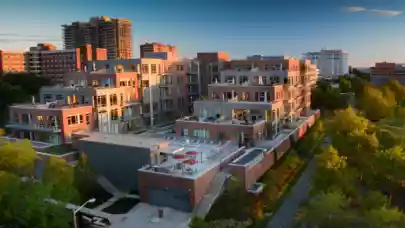
In the face of the housing crisis, the possibility of repurposing existing commercial buildings for residential use is receiving increasing attention. The question is: Can this approach provide a solution to the housing shortage in appropriate locations, and can it be profitable for developers? According to experts at the Urban Land Institute (ULI), changing trends in the office, retail, and hotel markets are making commercial adaptive reuse not just an option, but often a necessity.
In a comprehensive report, “Behind the Façade”, they analyse the cases of 30 conversions that have taken place in the U.S. in recent years. Their market observations suggest that such conversions have the potential to significantly impact the use of real estate. This is especially true for older B/C office buildings that are becoming functionally obsolete. The pandemic has accelerated this trend, driven by changing work patterns and the fact that overall post-pandemic demand for office space is lower than in the past and more concentrated in newer facilities.
A similar fate is facing older malls, which are losing ground in the era of online shopping. The explosive growth of online sales is negatively impacting old traditional retail formats that do not meet today's consumer expectations. The hotel segment is no different, where older properties may not meet the evolving needs of travellers.
"At the heart of the report is an examination of the challenges faced by ageing structures in the face of changing consumer preferences and technological advances. From 'right-sizing' struggles in retail and hotels to the inadequate adaptation of older industrial structures to modern demands, the report presents successful conversion as a solution not only to address housing shortages but also to breathe new life into communities," said Anita Kramer, Senior Vice President, ULI Center for Real Estate Economics and Capital Markets.
Developers can make money
Other factors in favour of adaptive reuse include faster turnaround times for such developments, less paperwork, and profits for developers. The vast majority of developers surveyed by the Urban Land Institute reported that their financial expectations for the project were met, and some even said they exceeded their original expectations.
A key element that was highlighted as a financial benefit was the speed of conversion compared to the traditional construction process. “Digging a hole, and pouring concrete is slow. Six to 10 months can be saved if the sequencing of the conversion work is done correctly. When evaluating a project, speed and its impact on IRR [internal rate of return] is something we look at closely,” says one developer interviewed.
Simplified paperwork
Repurposing buildings that have outlived their usefulness as commercial real estate is a trend spreading beyond the United States. European cities are also looking to repurpose run-down buildings, with residential use being one of the most desirable options encouraged by city officials.
Professor Uli Seher, founder of BRS Architectes and an architect and urban planner, points to the Renouvellement Morland project in Paris as an example of the successful adaptation of a former tax administration building.
"The new mayor of Paris concluded that excessive bureaucracy was holding back the market. The city selected 20 properties from its inventory and decided to sell, but not just at the best price. The mix of price and attractiveness of the project was the deciding factor," says the architect. "In the case of our project, the pre-regulation in the purchase agreement signed with the city eliminated the need for extensive permitting. Obtaining a quick permit with building conditions specified at the purchase stage accelerated the construction process. The challenge, however, was managing these obligations during construction, with potential consequences for non-compliance. The risk arises if these commitments aren't met by the end of the project, but no one has tested those waters yet," Uli Seher points out.
Renovation trend already visible in Poland
After more than 30 years of new construction, some commercial buildings in Poland no longer meet modern requirements, which will only become more stringent as climate policies are introduced. Some developers investing in older buildings are simply opting to demolish them to unlock the potential of the land and build from scratch. Others, however, are choosing to bring commercial buildings a dozen or more years old up to modern standards. This does not always mean changing their use to residential. Office buildings are being renovated and equipped with newer facilities or adapted for other public functions, such as the Hop and Diuna office buildings in Warsaw. However, there are new projects with plans to change their function to apartments, either for sale or for rent.
"The stock of obsolete commercial buildings is growing every year, and changing economic conditions and user habits raise questions about the future of such structures. The environmental aspect is not unimportant either, as it is less polluting to adapt an existing building than to demolish it and build a new one," says Marcin Juszczyk, Chair of the Urban Land Institute in Poland. "A possible and desirable solution could be to adopt such structures for residential use. Of course, this involves legal and technical challenges, but the experience of foreign companies shows that it is a profitable process. In addition to the developer, the community benefits – thanks to an expanding housing stock and reduced urban sprawl on the periphery – as well as the environment, which is not burdened with additional emissions. It is worth remembering that new construction accounts for about 11 percent of global CO2 emissions. As the Polish real estate market continues to mature, we will see more and more investment in redevelopment," argues Marcin Juszczyk.



